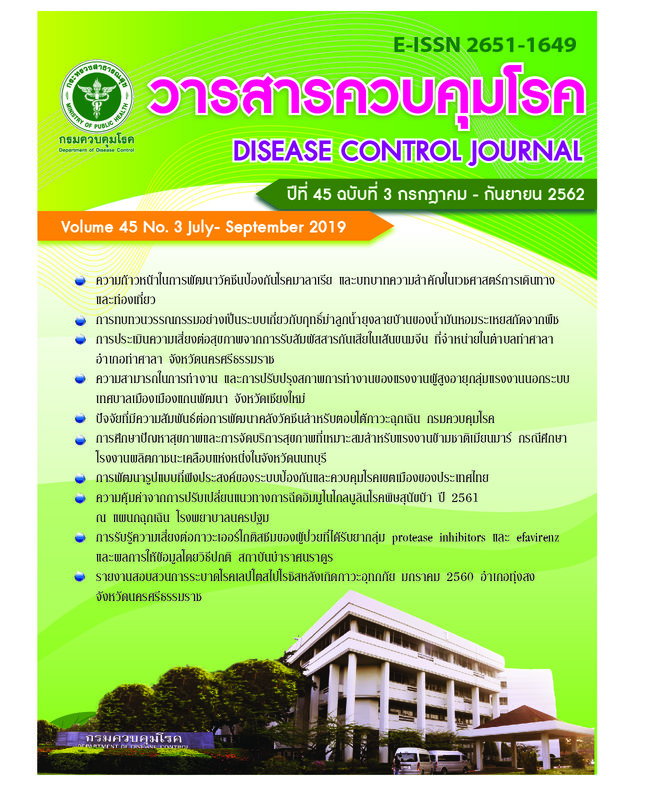Ergotism risk perception among patients receiving protease inhibitors (PIs) and efavirenz (EFV) and effect of drug information consultation, Bamrasnaradura Infectious Diseases Institute, Thailand
DOI:
https://doi.org/10.14456/dcj.2019.29Keywords:
ergotism, protease inhibitors, ergotamine, efavirenz, KAPAbstract
Taking ergot derivatives, anti-migraine drugs, among HIV/AIDS patients receiving protease inhibitors (PIs) or efavirenz was known as a risk factor for ergotism. Therefore, this study aimed to investigate ergotism risk perception and effect of drug information consultation among such patients. During October and November 2018, 373 OPD patients of Bamrasnaradura Infectious Diseases Institute (BIDI) were non-randomly enrolled and face-to-face interviews were performed. It was found that 53.6% experienced headaches in their lifetime, of these 2.2% ever had ergotamine. Two cases of ergotism were diagnosed with the prevalence of 10/1,000, among those experiencing headache. 30.6% of the 373 reported having received drug information consultations with respect drug interactions between these two groups of medications. Mean scores of the Knowledge was the lowest, followed by the Practice and Attitude with 20.3%, 70.3%, and 78.8%, respectively. Comparing with the patients reporting never receiving the consultation, the multiple logistic regression analysis showed that those receiving the consultation for every visit was 76.6 (95% CI = 32.1, 182.3) and 2.2 (95% CI = 1.0, 4.7) times more likely having higher knowledge and positive behavior, respectively. Therefore, integrating and improving the existing drug consultation system could effectively decrease ergotism and any drug interaction incidence among HIV/AIDS patients.
Downloads
References
2. Ongwandee S, Kiatburunakul S, Avihingsanon A, Sookkul E, Lolekha R, Editor. Thailand national guidelines on HIV/AIDS treatment and prevention 2017. Nonthaburi: Bureau of AIDS, Tuberculosis and Sexually Transmitted Infections, Department of Disease Control; 2017. (in Thai)
3. Bureau of Epidemiology, Department of Disease Control, Ministry of Public Health. Summary of the situation of AIDS and HIV infection in Thailand, 2015 [Internet]. [cited 2017 May 31]. Available from: http://www.boe.moph.go.th/files/report/20151126_87903337.pdf (in Thai)
4. Pornjirasil S. Migraine: Drug abuse is more dangerous than thought [Internet]. [cited 2017 May 31]. Available from: http://www.pharmacy.mahidol.ac.th/th/knowledge/article/310 (in Thai)
5. Avihingsanon A, Ramautarsing RA, Suwanpimolkul G, Chetchotisakd P, Bowonwatanuwong C, Jirajariyavej S, et al. Ergotism in Thailand caused by increased access to antiretroviral drugs: a global warning. Top Antivir Med 2014;21:165-8.
6. Adverse Drug Reaction Information Center, Bamrasnaradura Institute, Department of Disease Control, Ministry of Public Health. Report of adverse drug reactions in 2009. Nonthaburi: Bamrasnaradura Institute; 2009. (in Thai)
7. Adverse Drug Reaction Information Center, Bamrasnaradura Institute, Department of Disease Control, Ministry of Public Health. Report of adverse drug reactions in 2011. Nonthaburi: Bamrasnaradura Institute; 2011. (in Thai)
8. Friis RH, Sellers TA. Epidemiology for public health practice. 2nd ed. Gaithersburg, MD: Aspen; 1999.
9. Yamane T. Statistics, an introductory analysis. 2nd ed. New York: Harper and Row; 1967.
10. Suwan P. Measuring health: rating scales and questionnaires. Bangkok: Parbpim; 1994. (in Thai)
11. StataCorp. Stata statistical software: release 15. College Station, TX: StataCorp LLC; 2017.
12. Rosner B. Fundamentals of Biostatistics. 5th ed. Pacific Grove, CA: Duxbury Thomson Learning; 2000.
13. Suthiwet D. Interaction of anti-HIV drugs. Thai Journal of Pharmacy Practice 2017;9:448-462. (in Thai)
14. Szklo M, Nieto FJ. Epidemiology beyond the basics. Gaithersburg, MD: Aspen; 2000.
15. Gordis L. Epidemiology. 2nd ed. Philadelphia: W.B. Suanders; 2000.
16. Youngdam N, Nirakorn J. Results of educating patients taking PIs or Efavirenz to prevent ergotism in Phra Phutthabat Hospital. Journal of Clinical Pharmacy 2015;2-3:75-84. (in Thai)
17. Intarapim B, Rueanghongsa R. The effectiveness of education on drug interaction between Kaletra and Ergotamine in patients receiving antiretroviral therapy Kaletra, who received services at a Friend's Clinic in Si Sa Ket Hospital during April-August 2012. Si Sa Ket: Sisaket Hospital; 2012. (in Thai)
18. Munee-nam K. Factors related to knowledge, attitude, and practices in drug use among outpatients, Khuan Niang Hospital, Songkhla province. Journal of Clinical Pharmacy 2014;1:66-80. (in Thai)
19. Kongsaden T. Personal factors and understanding from counseling about drug use that affects drug adherence in HIV-infected patients. Journal of Clinical Pharmacy 2014;1:96-106. (in Thai)
Downloads
Published
How to Cite
Issue
Section
License
Articles published in the Disease Control Journal are considered as academic work, research or analysis of the personal opinion of the authors, not the opinion of the Thailand Department of Disease Control or editorial team. The authors must be responsible for their articles.






